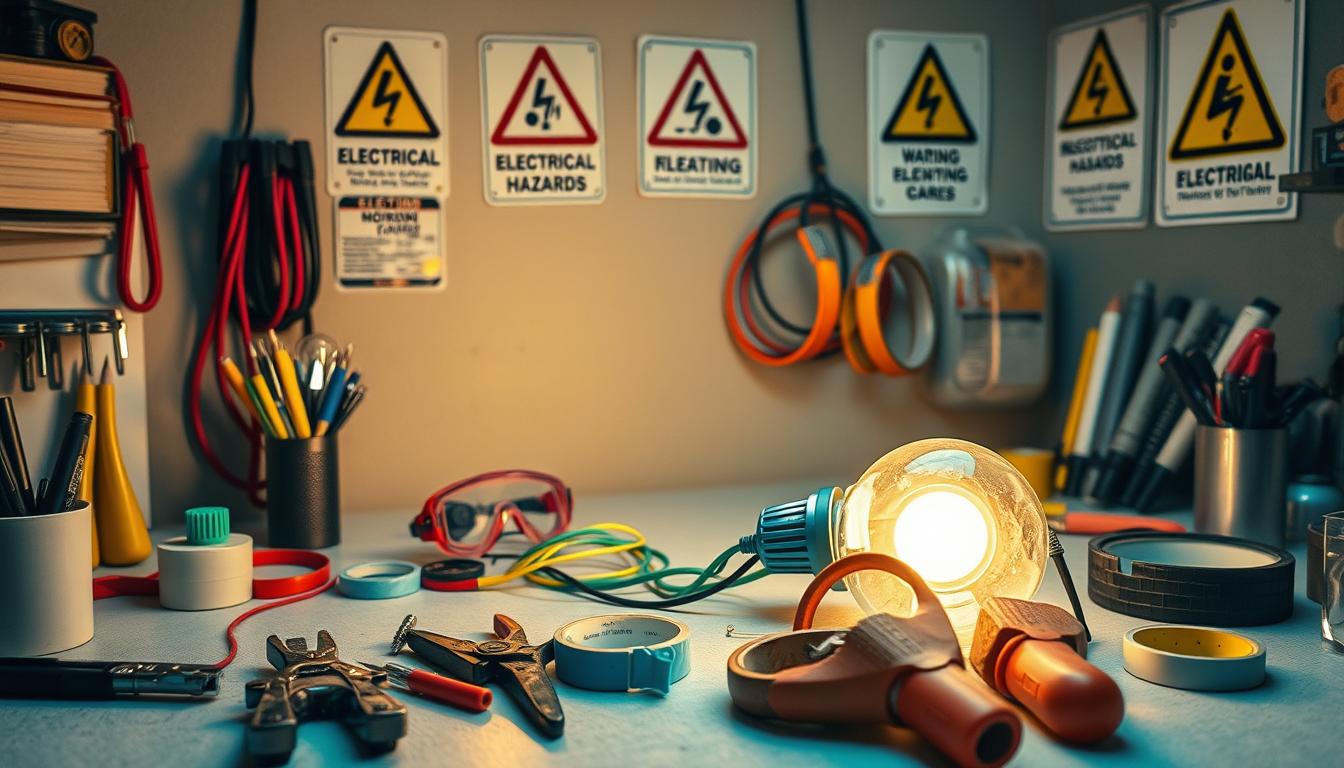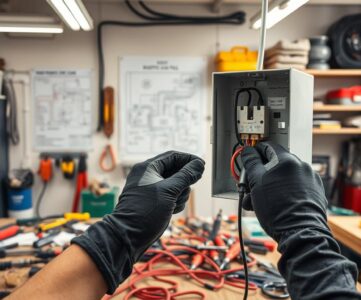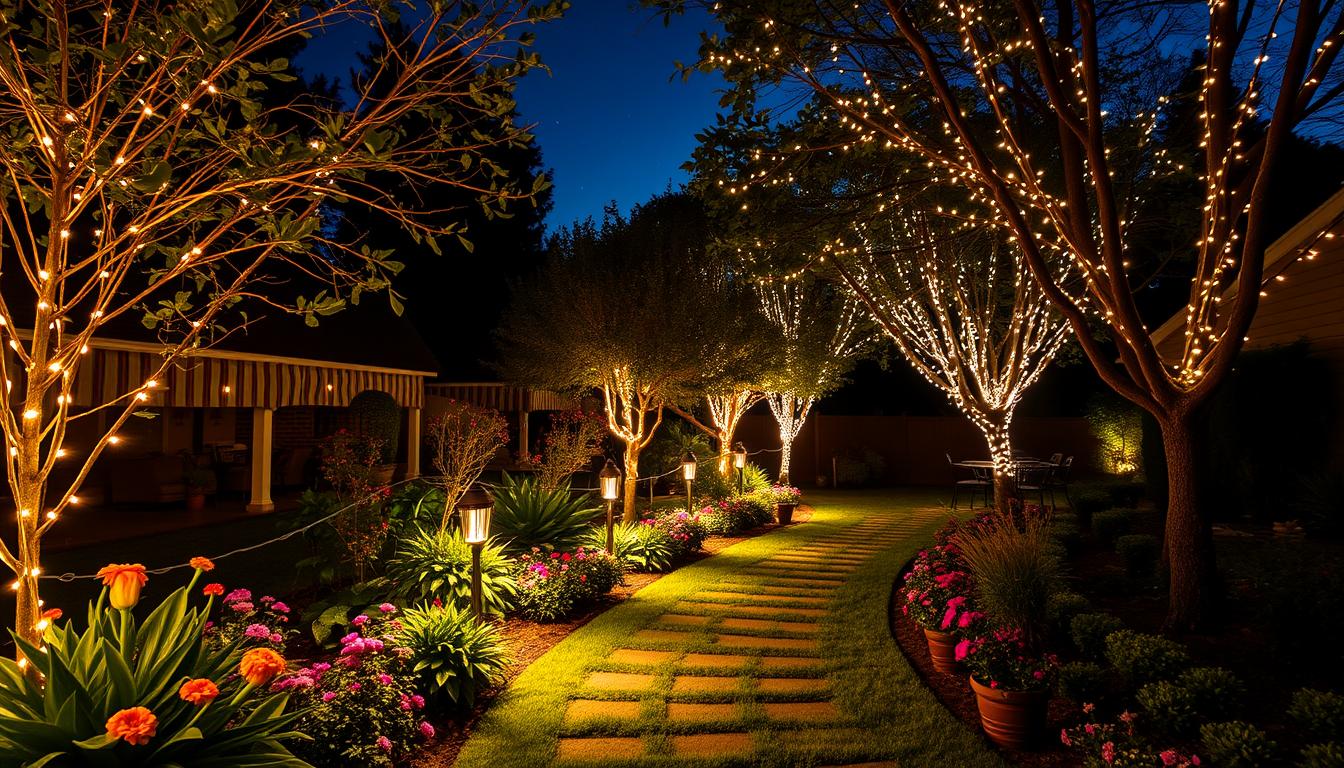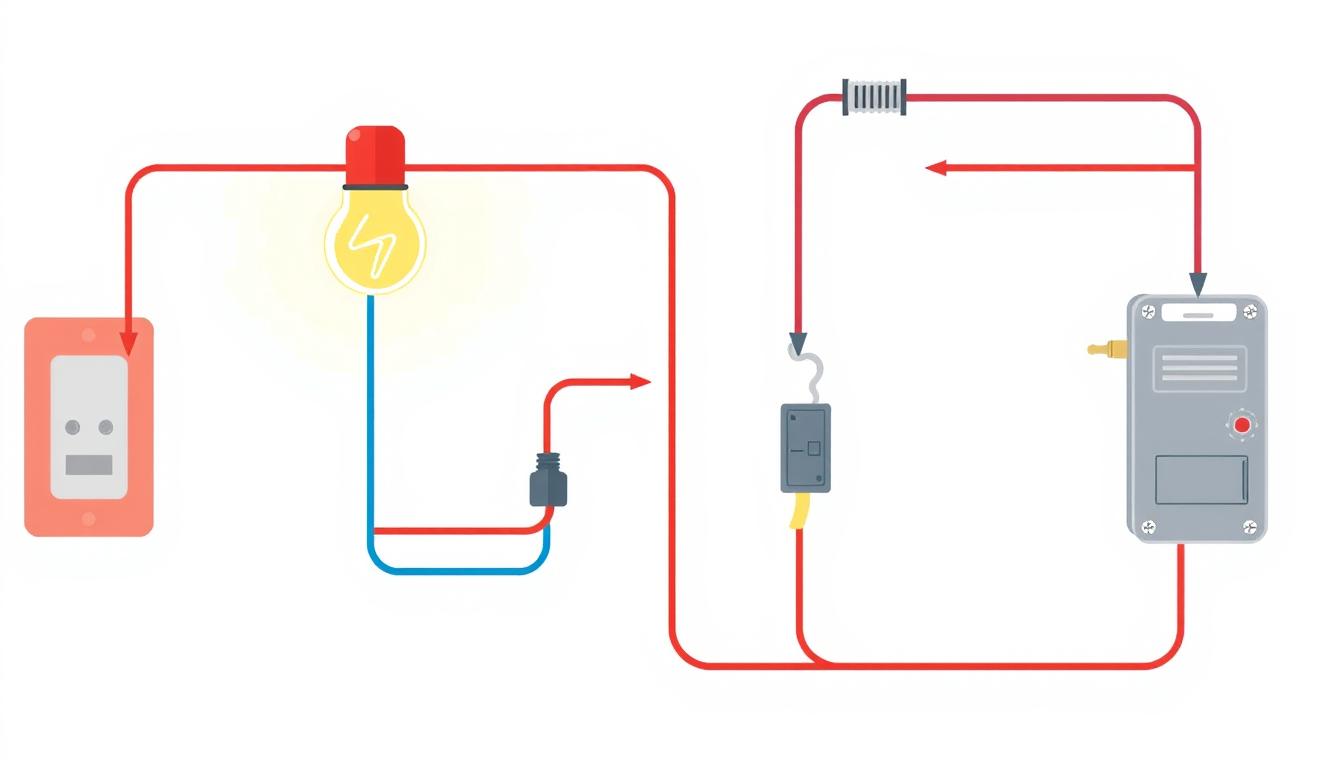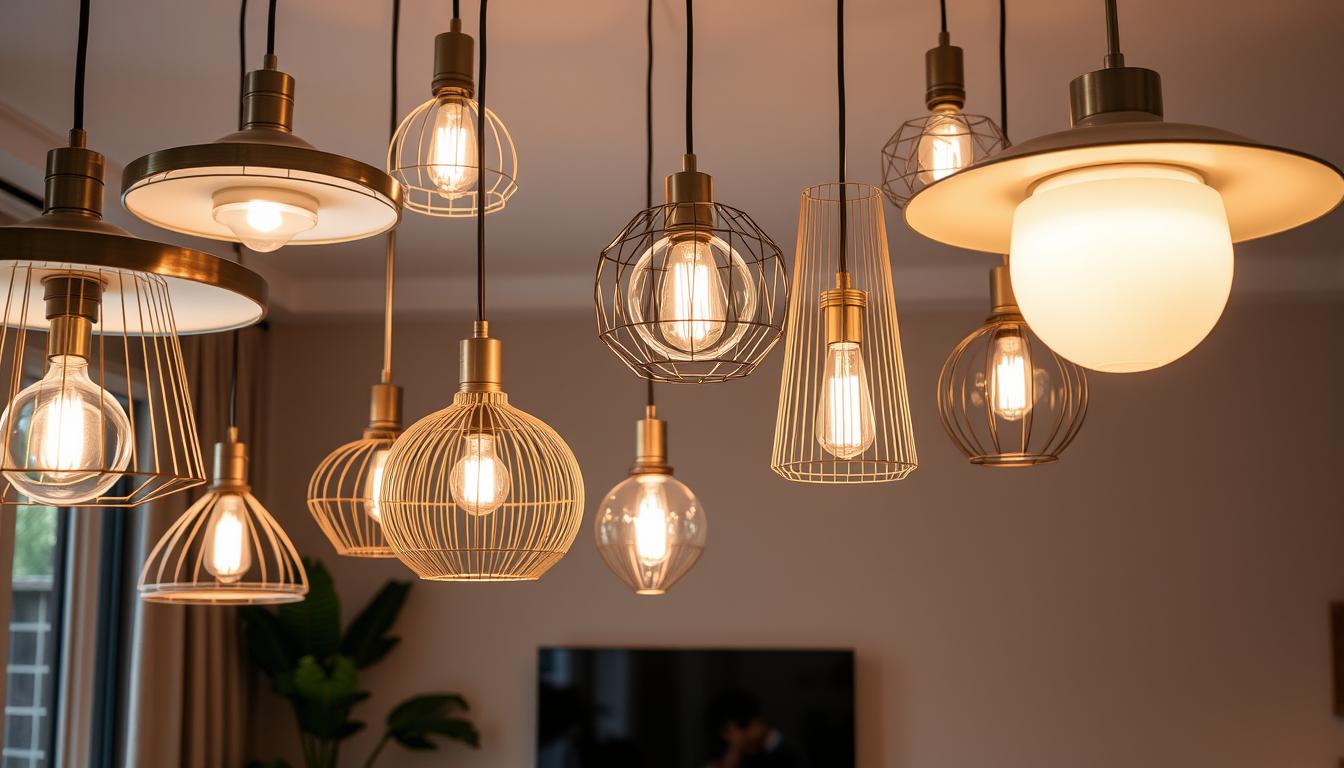DIY lighting projects need you to know electrical basics. It’s key for a safe and good job. Always follow safety steps to avoid dangers. This guide will give you light safety tips and electrical basics for your DIY project.
Working with electricity needs care and focus. Knowing electrical basics and safety steps is vital. This way, you can avoid electrical shock or fire.
In this guide, we’ll talk about electrical safety and DIY lighting. We’ll cover safety steps and electrical basics. Our aim is to help you do your DIY lighting project safely and well.
Introduction to Electrical Safety
Electrical safety is very important in DIY lighting projects. By following safety steps and knowing electrical basics, you can have a safe and good job.
Key Takeaways
- Understanding electrical basics is crucial for a safe and successful DIY lighting project
- Safety procedures should always be followed to avoid potential hazards
- Electrical safety is a critical aspect of any DIY lighting project
- Proper safety procedures can minimize the risk of electrical shock or fire
- Following electrical basics and safety procedures can ensure a safe and successful installation
Understanding Basic Electrical Concepts for Lighting Projects
DIY lighting projects need a basic grasp of electrical concepts for safety and success. Key concepts include voltage and amperage. Voltage is the electricity’s pressure, and amperage is its flow. Wire testing helps find the right voltage and amperage for your project.
In home lighting, you’ll deal with AC or DC power. AC is common in homes, while DC is in electronic devices. Circuit protection is crucial to avoid electrical shocks and fires. Fuses, circuit breakers, and GFCIs can protect circuits.
Voltage vs. Amperage Explained
- Voltage: measures the pressure of electricity
- Amperage: measures the flow of electricity
AC vs. DC Power in Home Lighting
AC power is used in homes, and DC in electronic devices. Knowing the difference is key for wire testing and circuit protection.
Reading Electrical Labels and Ratings
When using electrical parts, reading labels and ratings is crucial. Look for voltage, amperage, and safety info. Following these steps ensures a safe DIY lighting project.
| Concept | Explanation |
|---|---|
| Voltage | Measures the pressure of electricity |
| Amperage | Measures the flow of electricity |
| AC Power | Commonly used in households |
| DC Power | Often used in electronic devices |
Essential Safety Equipment for DIY Lighting Work
DIY lighting projects need the right safety gear to avoid accidents and succeed. Proper grounding is key to prevent electrical shocks. A good grounding kit is a must. Also, tool safety is crucial, and the right tools can prevent injuries.
A good toolkit for DIY lighting includes wire strippers, pliers, and safety glasses. It’s important to use these tools safely and right. For instance, wire strippers should strip insulation without harming the wire. Pliers should grip and bend wires safely.
- Insulated screwdrivers to prevent electrical shocks
- Non-contact voltage testers to detect live wires
- Work lights to illuminate the work area
Investing in these safety tools and following safety rules helps DIYers have a safe and successful project. Remember,proper groundingandtool safetyare vital to avoid accidents and ensure success.
Preparing Your Workspace for Light Installation
Before starting any light installation project, it’s crucial to prepare your workspace. You need to create a clean area, organize your tools, and ensure good lighting and air. These steps help you work safely and efficiently. Knowing electrical basics is also key to avoid risks.
A clean workspace is essential for a successful installation. Clear the area of clutter, cover floors and surfaces, and remove fragile items. This lets you focus on the task without distractions. Good lighting and air are also important to prevent accidents and keep you comfortable.
Creating a Safe and Efficient Workspace
To make a safe and efficient workspace, consider these tips:
- Organize your tools and materials in a logical and accessible manner
- Use a workbench or table to keep your work area clean and clutter-free
- Ensure proper lighting and ventilation to prevent accidents and discomfort
By following these tips and taking the necessary precautions, you can safely and efficiently complete your light installation. Always follow electrical basics and best practices to avoid hazards.
Light Safety Fundamentals Every DIYer Must Know
Working with lighting requires following safety procedures to avoid accidents. A key step is wire testing, which spots hazards and prevents shocks. Knowing about safety procedures and wire testing helps DIYers create a safe, bright space.
To start, you need the right tools. This includes a multimeter for wire testing, a voltage tester, and insulated gloves. Having these tools ensures DIYers follow safety procedures to protect themselves and their work.
- Turning off the power to the circuit before starting work
- Using insulated tools and equipment
- Avoiding overloading circuits
- Keeping work areas clean and well-lit
By sticking to these safety procedures and doing regular wire testing, DIYers can enjoy a safe lighting experience.
| Safety Procedure | Importance |
|---|---|
| Wire Testing | Identifies potential electrical hazards |
| Insulated Tools | Prevents electrical shocks |
| Circuit Overload Protection | Prevents fires and electrical damage |
By focusing on safety procedures and wire testing, DIYers can ensure a safe and successful lighting project.
Circuit Protection and Breaker Basics
Circuit protection is key to avoiding electrical shocks and fires. Knowing your home’s electrical panel is vital. It helps ensure you have the right circuit protection. You need to understand the different types of breakers and fuses and how to install and maintain them.
Proper grounding is also crucial. It means all electrical parts are connected to the ground. This prevents electrical shocks and fires. Proper grounding is needed for all electrical systems, like lights and appliances.
Understanding Your Home’s Electrical Panel
Your home’s electrical panel is where all electrical power starts. It has circuit breakers or fuses that manage electricity to different areas. Knowing how to read and use your electrical panel is key for your safety and your home’s safety.
GFCI Protection Requirements
GFCI (Ground Fault Circuit Interrupter) protection is needed in areas with water, like bathrooms and kitchens. GFCI outlets stop electricity flow if there’s a ground fault. This helps prevent electrical shocks and fires.
Proper Fuse Selection
Choosing the right fuse is vital for circuit protection. Fuses blow when there’s too much electricity, protecting your system and reducing fire risk. It’s important to pick the right fuse and follow the manufacturer’s advice.
By following these tips, you can keep yourself and your home safe. Always follow the manufacturer’s instructions and get help from a pro if you’re unsure about your electrical system.
Wire Selection and Management
Choosing the right wire is key for safe and efficient DIY lighting projects. Think about the voltage and amperage needs of your lights and how far they are from the power source. Also, remember to use safe tools to avoid injury or damage.
Here are some tips for managing your wires well:
- Use a wire organizer or cable management system to keep your wires tidy and prevent tangles.
- Label your wires clearly to avoid confusion and ensure that you can identify the correct wires during installation.
- Follow installation precautions such as turning off the power to the circuit before starting work, and using a voltage tester to verify that the power is off.
By following these tips and taking the right installation precautions, you can have a safe and successful DIY lighting project. Always put tool safety first and use the correct tools for the job.
Here is a summary of the key considerations for wire selection and management:
| Factor | Consideration |
|---|---|
| Voltage | Choose a wire that can handle the required voltage |
| Amperage | Select a wire that can handle the required amperage |
| Distance | Choose a wire that is long enough to reach from the power source to the fixture |
Proper Grounding Techniques for Light Fixtures
Electrical basics and safety procedures are key to avoiding accidents and ensuring a safe lighting system. Grounding is crucial as it protects people and equipment from electrical shocks. Understanding ground wire installation and avoiding common mistakes is essential.
In the United States, electrical safety standards require proper grounding to prevent hazards. DIYers can make their lighting projects safe and compliant by following these guidelines. Key considerations for proper grounding include:
- Using the correct gauge and type of ground wire for the specific lighting fixture
- Ensuring all metal parts of the fixture are properly grounded
- Avoiding common grounding mistakes, such as inadequate wire sizing or incorrect connections
Testing ground connections is also vital. It confirms the grounding system is working right. By focusing on electrical basics and safety, DIYers can create a safe and reliable lighting system.
By following these guidelines and best practices, individuals can ensure their lighting projects are safe and meet electrical standards. Remember, proper grounding techniques are key to preventing electrical shocks and ensuring a safe lighting system.
| Grounding Technique | Importance |
|---|---|
| Ground Wire Installation | Prevents electrical shocks and ensures safety |
| Common Grounding Mistakes | Avoids inadequate wire sizing or incorrect connections |
| Testing Ground Connections | Verifies the grounding system is functioning correctly |
Installation Best Practices
When installing lighting, wire testing is key for safety. It checks wires for damage and ensures they can handle the needed voltage and amperage. Also, circuit protection is vital to avoid electrical shocks and fires.
To ensure a safe and successful installation, follow these best practices:
- Turn off the power to the circuit before starting work
- Use a multimeter to test the wires and circuit
- Install GFCI outlets in areas where water is present
- Use wire nuts or connectors to secure loose wires
A well-planned installation considers wire testing and circuit protection. Choose the right wires and materials. Also, make sure the circuit is protected with fuses or circuit breakers.
By following these best practices and taking precautions, you can have a safe and successful lighting installation. Always follow the manufacturer’s instructions and local electrical codes. If unsure, don’t hesitate to seek professional help.
| Installation Step | Importance |
|---|---|
| Wire testing | High |
| Circuit protection | High |
| Grounding | Medium |
Testing and Troubleshooting Methods
Working with electrical systems requires knowing how to test and troubleshoot. This means using multimeters safely and spotting common wiring problems. Proper grounding is key to keeping your electrical system safe. Always follow safety rules and best practices when dealing with electricity.
To fix electrical issues, follow these steps:
- Turn off the power to the circuit at the main electrical panel
- Use a multimeter to test for voltage and continuity
- Check for loose connections and damaged wires
Remember, tool safety is crucial when working with electricity. Use insulated tools and follow the multimeter’s instructions. If you’re not sure about anything, get a professional electrician’s help.
By following these steps and focusing on proper grounding and tool safety, you can troubleshoot safely and effectively. Always stick to safety guidelines and best practices. If you’re unsure, don’t hesitate to ask for professional help.
| Troubleshooting Step | Importance |
|---|---|
| Turn off power to the circuit | High |
| Use a multimeter to test for voltage and continuity | Medium |
| Check for loose connections and damaged wires | High |
Emergency Procedures and Safety Protocols
Working with electrical systems means being ready for emergencies. Installation precautions help avoid accidents, but knowing emergency steps is key. We’ll discuss how to handle shocks, fires, and other dangers.
Knowing electrical basics is crucial in emergencies. This includes how to shut off power, use fire extinguishers, and give first aid. Having a plan for emergencies is also important, like knowing how to leave and where to meet.
Here are some key steps for an electrical emergency:
- Turn off the power supply
- Call emergency services
- Provide first aid if necessary
- Evacuate the area
Preventing accidents is also key. Follow electrical basics like using the right wiring and ensuring systems are grounded. This helps avoid emergencies.
By following these steps and taking installation precautions, you can prevent accidents. Always prioritize electrical basics and take precautions to avoid emergencies.
| Emergency Procedure | Steps to Take |
|---|---|
| Electrical Shock | Turn off power supply, call emergency services, provide first aid |
| Electrical Fire | Turn off power supply, use fire extinguisher, evacuate area |
Maintaining Your DIY Lighting Projects
Keeping your DIY lighting projects in good shape is key. This means doing regular checks to spot problems early. By following safety steps and testing wires, you can avoid accidents and keep your lights working right.
Also, cleaning and checking your lights and electrical parts is important. It stops dust and corrosion from causing trouble. A well-kept lighting system not only shines brighter but also keeps you safe from shocks and fires.
Regular Safety Checks
It’s vital to do safety checks often to catch hazards before they cause trouble. Look for any damage or wear on wires and electrical parts. Also, make sure your lights are working as they should.
Cleaning and Inspection Schedule
Having a cleaning and inspection plan helps keep your lights safe and working well. Here’s what your schedule should include:
- Monthly: Clean and check your lights and electrical parts
- Quarterly: Test your wires and electrical connections
- Annually: Check and test your whole lighting system
Updating Older Installations
Older lighting setups might not be safe anymore. Updating them is a smart move to avoid accidents and follow the rules. You might need to replace old parts, rewire, or get new lights. Always follow safety rules and test your wires to make sure your updates are safe and work well.
Conclusion: Illuminating Your Space Safely and Successfully
Starting your DIY lighting projects? Remember, circuit protection and proper grounding are key for safety and lasting results. This guide has given you the tools to light up your space safely and effectively.
This article covered the basics of electrical work and how to install lights correctly. Always put safety first, using the right gear and wiring methods. Check your work often and keep up with maintenance to ensure your lights stay in top shape.
Doing it right the first time keeps everyone safe and saves you from future headaches and expenses. Enjoy the process of lighting up your space and feel proud of your work.
